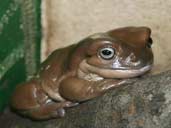 |
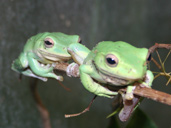 |
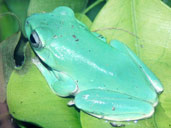 |
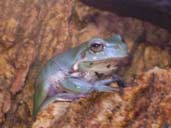 |
White’s Tree Frog (Litoria caerulea) Care Sheet
Common names: White’s Tree Frog
Scientific Name: Litoria caerulea
Description
Description: White’s Tree Frogs are the most common type of tree frogs to be kept as pets. They come in a range of colours from bright green, to olive green and even to shades of blue, but they also have the ability to change colour in reaction to their mood and surroundings. They have a chubby appearance and faces which seem always to be set in a smile. They are designed well for life in the trees, with strong hind legs and a good grip.
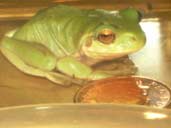 Size: White’s Tree Frogs can grow between 5 to 10 cm (2 to 4 inch), with females growing larger than the males.
Size: White’s Tree Frogs can grow between 5 to 10 cm (2 to 4 inch), with females growing larger than the males.
Life span: White’s Tree Frogs can live between 15 and 20 years with appropriate care.
Origin: White’s Tree Frogs are native to Australia and Indonesia, but can also be found in New Guinea and New Zealand.
Habitat: White’s Tree Frogs live in rainforests and similar tropical forests. They are arboreal so spend much of their time off the ground. They are usually found near to ponds or other water sources.
Captive Care
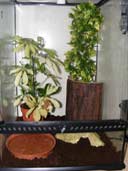 Temperament: White’s Tree Frogs are placid creatures, so they make great pets. They have good personalities and are fun to watch.
Temperament: White’s Tree Frogs are placid creatures, so they make great pets. They have good personalities and are fun to watch.
White’s Tree frogs can be housed with other tree frogs, but care must be taken to ensure they are similar sized to avoid cannibalism, as White’s tree frogs may eat smaller frogs if given the opportunity.
Housing: Adult White’s Tree Frogs are arboreal, so require a taller terrarium than most amphibians. Try to give them more height to enable you to incorporate the thick branches on which they will spend the majority of their time.
Exoterra terrariums are great for White's Tree Frogs and come in a range of sizes.
Your White's Tree Frog's terrarium should contain:
Substrate: A coco husk substrate, sandy top soil or compost (without fertilisers), orchid bark chips, sphagnum moss, peat, live moss and a selection of live plants will help increase the humidity in the setup (see plant list in the forum) can all be used in your set-up. Set-up tips can also be found on the forum.
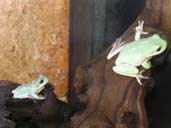 A place for your White’s Tree Frog to hide and climb: White’s Tree Frogs need plenty of branches and plants within their terrarium for climbing purposes. They will spend the majority of their time on these branches, so it is important that they are sturdy enough to carry their weight.
A place for your White’s Tree Frog to hide and climb: White’s Tree Frogs need plenty of branches and plants within their terrarium for climbing purposes. They will spend the majority of their time on these branches, so it is important that they are sturdy enough to carry their weight.
All amphibians require somewhere to hide and may become stressed if this is not provided. In the case of Whites Tree Frogs they will spend more time at the top of the tank, so place hides here. Large Bamboo canes provide great hiding places for Whites Tree Frogs and can be hung horizontally across the tank with wire.
Logs and cork bark make good natural looking additions to your terrarium and make great hiding places. Plants and stones can also be used.
Stones or branches from the wild need to be debugged by soaking first in chlorine/water solution, then rinsed thoroughly, soaked in clean water, then left to dry in the sun. Some live plants may be harmful to your White’s Tree Frog, if in doubt please see the list of safe plants which can be used in the forum.
A change of scenery: White’s Tree Frogs are very inquisitive animals and like to explore new surroundings. Once in a while change the layout of the terrarium; this will keep your White’s Tree Frog from becoming bored. You will notice once you put your White’s Tree Frog(s) back in the tank it will start to re-explore its new surroundings.
Water
All amphibians need fresh water daily. A large water bowl should be given (no deeper than the White’s Tree Frogs height when at rest) with de-chlorinated or bottled spring water. The water should be changed daily to avoid the build up of bacteria.
White’s Tree Frogs like most amphibians will soak up water through their skin and since their water bowl is used as the main place to defecate it is important that it is cleaned regularly.
Humidity
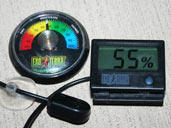 White’s Tree Frogs require humidity of between 50-60% to recreate the conditions they would experience in the wild.
White’s Tree Frogs require humidity of between 50-60% to recreate the conditions they would experience in the wild.
To keep the humidity at the correct level a large water bowl and regular misting with de-chlorinated water from a spray bottle is necessary.
A hygrometer should be used to monitor humidity levels in your terrarium. Both digital and dial hygrometers are readily avaialable from reptile stockists and are relatively cheap to purchase.
Heat
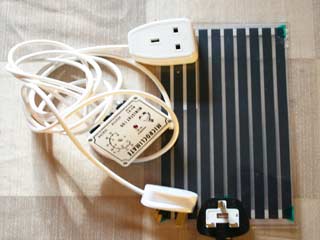 The ideal temperature for your White’s Tree Frogs is a temperature gradient of 25-30°C (77-85°C) with a slight temperature drop at night or 2 or 3 degrees.
The ideal temperature for your White’s Tree Frogs is a temperature gradient of 25-30°C (77-85°C) with a slight temperature drop at night or 2 or 3 degrees.
Heat should be provided using a heat mat with thermostat. Heat mats should only cover between a third and a half of the vertical space to allow your White’s Tree Frog to thermo regulate.
Never use heat lamps or basking lamps for amphibians, as these can cause your White’s Tree Frogs to dehydrate.
It's useful to have a small thermometer on either end of the terrarium to check the temperature. One end should be around 25°C and the other around 30°C. Your White’s Tree Frogs will thermo-regulate by moving around the tank.
Feeding your White's Tree Frog
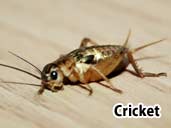 |
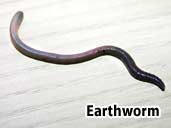 |
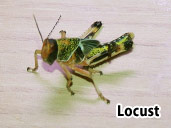 |
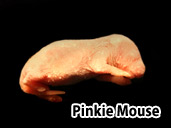 |
White’s Tree Frogs should be fed 2-3 times a week with a varied diet of appropriately sized gut loaded insects, including locusts, crickets, earthworms and caterpillars. Feed 4 or 5 insects per White’s Tree Frog per feeding. The live food should be dusted with calcium and vitamin supplements once a week.
As adults your White’s Tree Frog should be able to feed on the occasional pinkie mouse, but you should regard this as a treat item as regular feedings on mice can cause your Tree Frog to become obese. In the wild, White’s tree frogs may also eat small lizards and other, smaller frogs, but these are harder to obtain as a food source in the pet trade.
Lighting
A fluorescent UVB tube will provide sufficient light to keep your White’s Tree Frogs happy.
Cleaning
Your White’s Tree Frog’s terrarium should be inspected and spot cleaned daily when changing the water. Every two to three weeks clean out the tank completely and sterilise using a reptile/amphibian friendly disinfectant. Sterilise any décor and carefully remove any live plants to replace when the tank has been cleaned. Your White’s Tree Frogs should be moved to a temporary tank whilst being cleaned.
Handling your White's Tree Frog
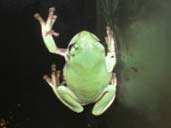 White’s Tree Frogs have delicate skin, but can tolerate moderate handling. Make sure you have moist and clean hands or wear gloves.
White’s Tree Frogs have delicate skin, but can tolerate moderate handling. Make sure you have moist and clean hands or wear gloves.
White’s Tree Frogs may look like they have slimy skin, but appearances can be deceptive, because you will find upon handling them that they feel more waxy than slimy.
White’s Tree Frogs have an excellent grip, so it is unlikely that you would drop them during a handling experience.
When cleaning your terrarium you can safely remove your White’s Tree Frogs to another tank using an aquarium net usually used for pet fish.
Sexing
Females tend to be larger than males, with males having darker throat areas. Males are also known to call to attract potential mates during the breeding season.
Things to consider when purchasing your first Amphibian
• Who will look after your new pet if you are away?
• Can you get food easily from your local pet shop?
• Can you deal with feeding live insects as food?
• Can you handle the live food to feed your pet?
• Is the rest of the family happy to live with an amphibian?
Other questions about the White’s Tree Frog
This care sheet is a simple step-by-step guide to successful White's Tree Frog keeping, but if you have any more questions or need more specific information about the keeping of White's Tree Frogs, please enter our forum. It is a useful resource where you can ask members to share good practice and also talk about your experiences of being a White's Tree Frog keeper.

